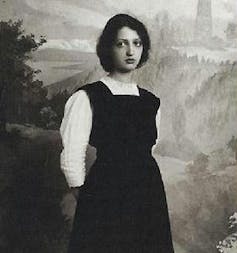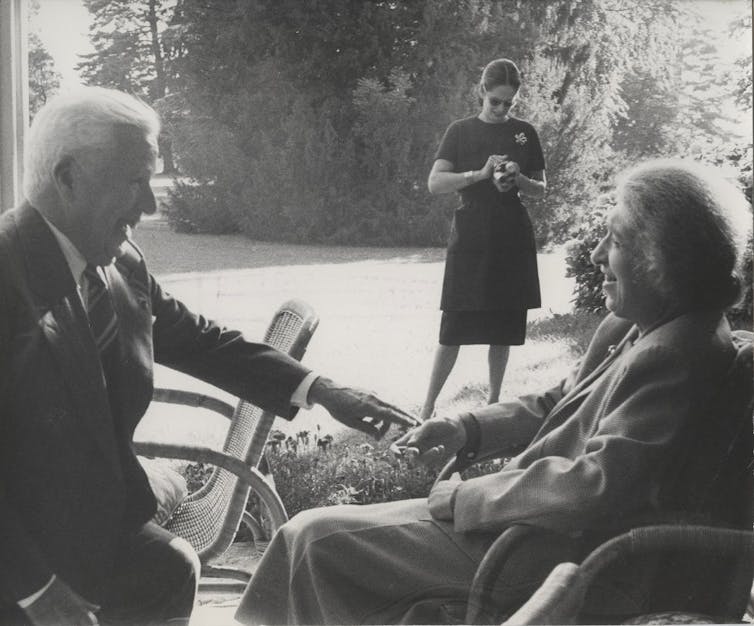Virginia Sánchez Rodríguez, Universidad de Castilla-La Mancha
Many of the women who pursued careers in music during the turbulent 20th century led extraordinarily complex and exciting lives. As well as confronting the stereotypes that women artists have long faced, they often lived and worked in the midst of war. Despite their accomplishments, their names are not always known by the general public. Romanian pianist Clara Haskil is one of them.
An expert musician, Haskil was one of the most outstanding solo performers of the 20th century.
Who was Clara Haskil?
Haskil was born in Bucharest in 1895 into a Sephardic Jewish family. She received her first piano lessons from her mother, Berthe Haskil. From an early age, Haskil demonstrated excellent skills, including a capacity to reproduce musical works heard only once. Haskil’s family, aware of her musical talent, decided that she should move to Vienna with one of her uncles when she was seven, and later to Paris, where she received lessons in piano and violin.
Her time in the French capital marked the beginning of her successes. In 1910 she won first prize for piano in a competition organised by the Conservatoire de Paris, which was considered the best in the world at the time. She soon began to give concerts in France, Austria, Italy and Switzerland.
When she was fifteen, she met the Italian pianist and conductor Ferruccio Busoni in Zurich. Upon hearing her at one of her performances, he invited her to continue her studies under his tutelage in Berlin. Haskil declined – a decision she apparently regretted for the rest of her life.
Overcoming adversity
The outbreak of World War I in 1914 coincided with the loss of Haskil’s mother, the arrest of her uncle and numerous health problems due to the deforming scoliosis she had been diagnosed with. After the end of the war, and a long period of immobilisation in a plaster corset following surgery, she became increasingly active as a concert pianist.
 Portrait of a young Clara Haskil.
Wikimedia Commons
Portrait of a young Clara Haskil.
Wikimedia Commons
Although she continued to live in France, Switzerland became an important place for Haskil. There she found a climate favourable to her health, a friendly atmosphere and the beginning of admiration from the European public. In Vienna, the press hailed her as “a new star” after her concerts in 1923.
The United States also fell at her feet. She achieved enormous success after her first tour in 1924, triumphing in New York and getting excellent reviews in the leading newspapers: “Clara Haskil, fresh from Paris, gave a remarkable demonstration of flying fingers in her first New York recital at Aeolian Hall” (New York Herald).
Although critics were always enthusiastic about her performances, her letters exude a strong self-demanding and constant non-conformism. This was an artist in search of perfection that she never quite found to a satisfactory degree. All this was probably responsible for the stage fright she suffered throughout her life, which she managed to live with.
Concerto for piano and orchestra no. 20 by Mozart. Piano soloist: Clara Haskil (1954)
Haskil was, in the words of Jeremy Siepmann, “musician for musicians” and “pianist for pianists”. However, the outbreak of World War II, which coincided with new health problems, again interrupted her career, as well as instilling in her the fear of being captured for being Jewish.
From a financial point of view, it was also a difficult time due to the absence of concerts in Paris, where she lived, and the fact that, during those years, it was not possible for foreigners to play on the radio. However, thanks to her friends and admirers, she managed to obtain the necessary papers to be admitted to Switzerland in 1942.
Clara Haskil’s friends and colleagues
Friendships were fundamental in the pianist’s life. Some of them helped her financially and socially. Winnaretta Singer, the Princess of Polignac, who was a patron of great musicians, placed one of the pianos in her Parisian mansion at Haskil’s disposal and even introduced her to an elite cultural circle by regularly inviting her to his salon.
She enjoyed collaborations with leading musicians such as Pau Casals, Eugène Ysaÿe and Herbert von Karajan, with whom she shared a successful tour of Vienna and Salzburg. On a personal level, she enjoyed a deep friendship with the Romanian pianist Dinu Lipatti.
However, Charlie Chaplin was perhaps the most famous of her friends. It was common for the Chaplin family to visit the pianist at her house in Vevey, and they celebrated Christmas on several occasions in the Manoir de Ban, owned by the actor. He was the one who most publicly professed his admiration for her, as can be seen in these words from a radio interview in 1962:
During my life I have known three geniuses. One was Clara Haskil. The others were Professor Einstein and Sir Winston Churchill.
 Photograph by Charles Chaplin and Clara Haskil.
Louise Productions
Photograph by Charles Chaplin and Clara Haskil.
Louise Productions
Role model
Haskil was not an assiduous live performer, however. She was not big on social interactions, and, more importantly, she didn’t have an agent. Fortunately, we can enjoy her legacy through her recordings.
In 1947 she made his first commercial recording for Decca, performing Beethoven’s Concerto for Piano and Orchestra No. 4 with the London Philharmonic Orchestra conducted by Carlo Zecchi.
Haskil’s performances are characterised by precision and agility. One can observe a light touch and a great naturalness with no abuse of the pedal. Her favourite composer was Mozart. Her performances of his piano compositions is a reference for pianists worldwide.
Mozart’s Sonata K 330. Piano: Clara Haskil (1954)
She became not only an outstanding soloist, but also an outstanding performer of chamber music. This can be seen in the recordings of the Sonatas for violin and piano by Mozart and Beethoven together with the Belgian violinist Arthur Grumiaux. Their recordings demonstrate harmony and closeness to the composer’s text. The personal and professional relationship with Grumiaux lasted until the end of his life.
Clara Haskil’s recordings of the works of Robert Schumann have also become benchmarks. Both in the German composer’s microforms –such as Children’s Scenes Op. 15 and Forest Scenes Op. 82– and in the Piano Concerto in A minor, one can see Haskil’s technical mastery and her appreciation of a certain sense of freedom.
Although she was acclaimed by audiences and critics during her lifetime, the greatest recognition of her career is that her legacy has passed to posterity through the magic of recordings that mean her musical vision will live on forever.
Virginia Sánchez Rodríguez, Profesora Contratada Doctora de la UCLM. Miembro del Centro de Investigación y Documentación Musical (CIDoM)-Unidad Asocida al CSIC. Especialista en música del cine español y mujeres músicas de los siglos XIX y XX., Universidad de Castilla-La Mancha
This article is republished from The Conversation under a Creative Commons license. Read the original article.